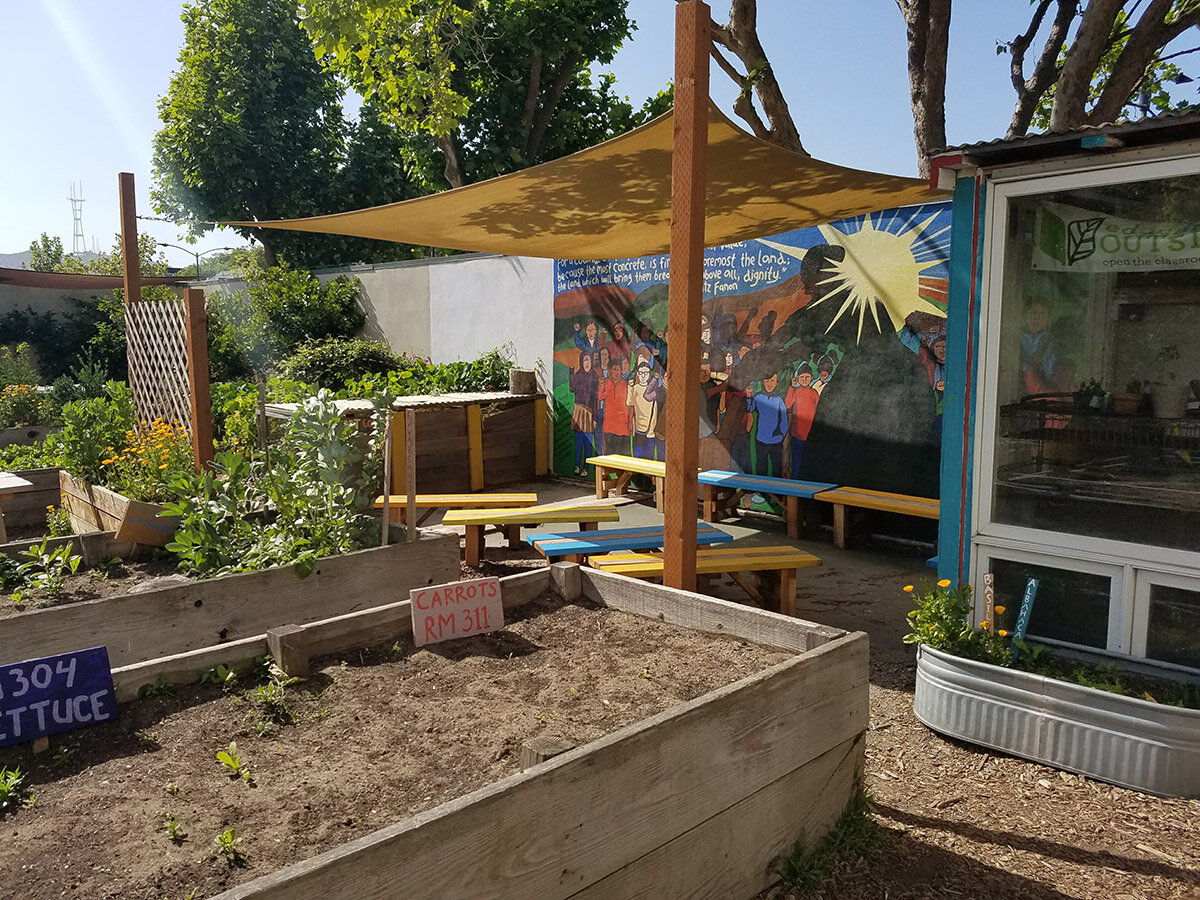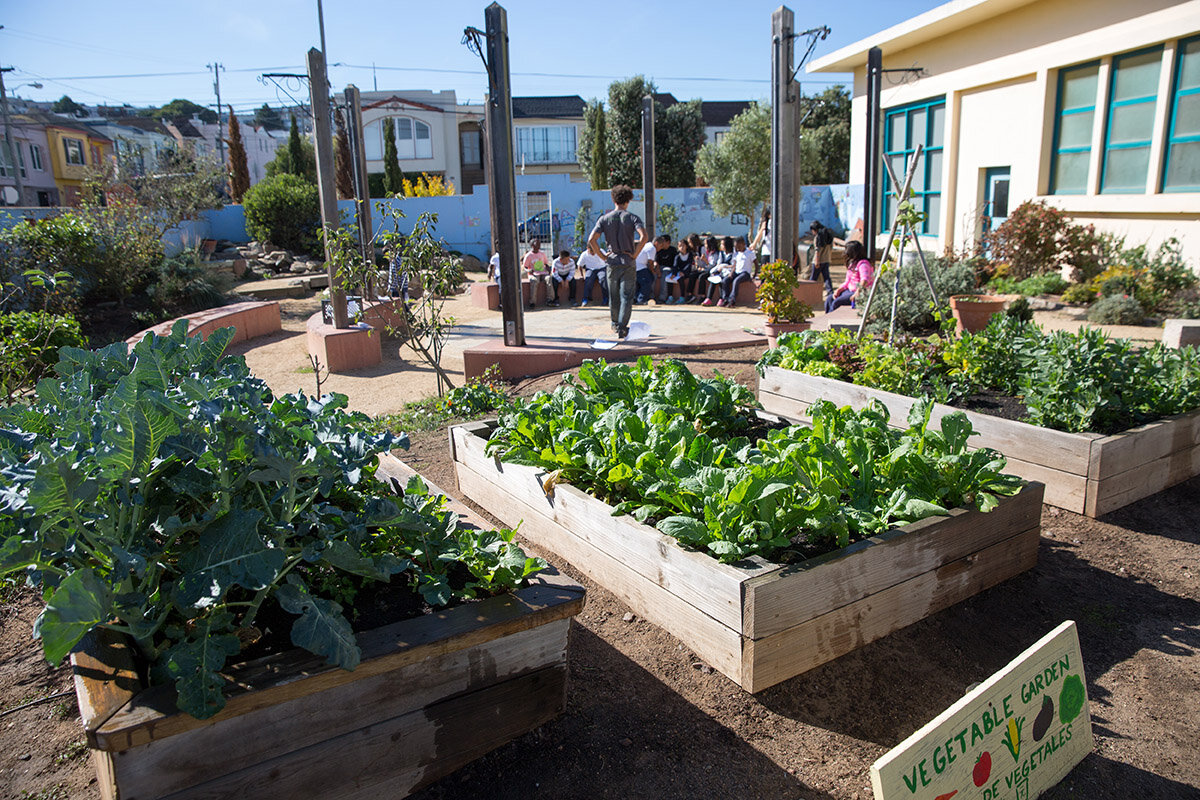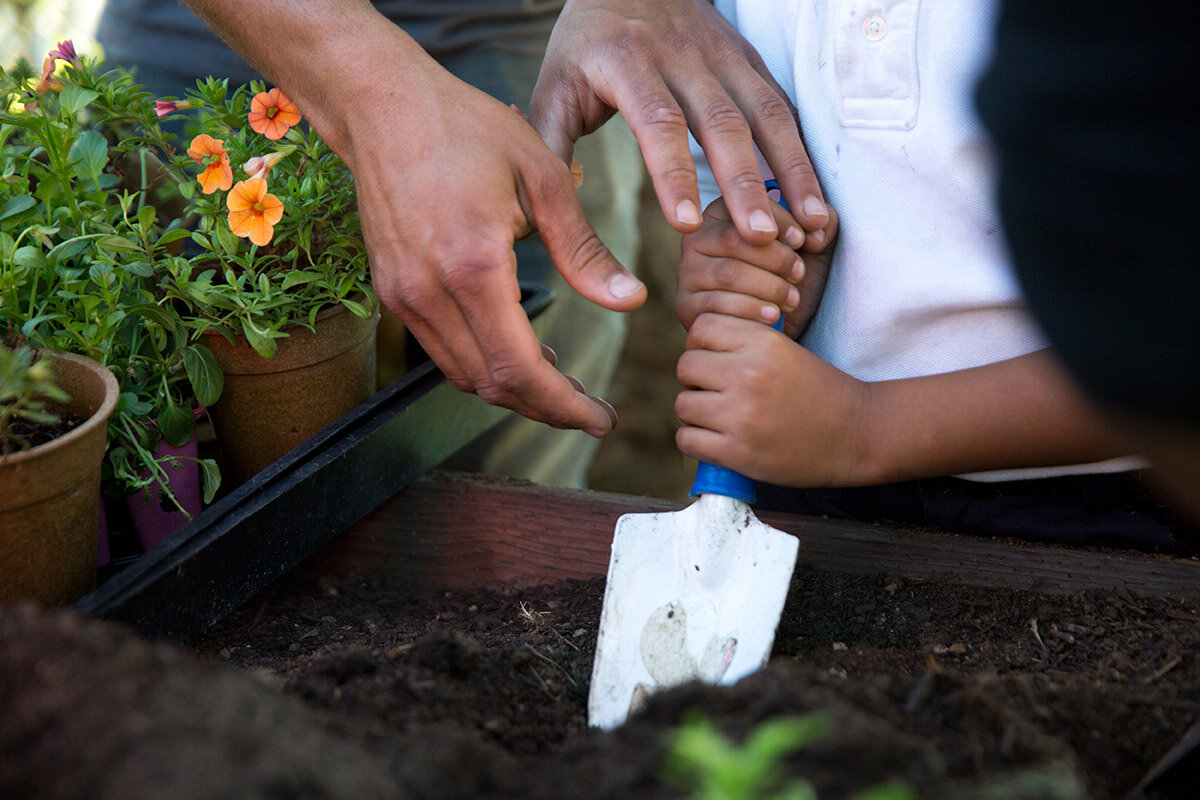School Gardens — Design and Teaching
Here, in Part 2 of our school garden introduction, we review basic design ideas that will help schools and districts create an outdoor classroom that is conducive to learning. For a comprehensive guide to creating outdoor spaces, please see that section of our library.
In this article, we also consider what might be taught in the school garden. From connecting the garden to standards to cooking outside with students. For more information please see our articles on curriculum, outdoor classroom management, ensuring a positive experience outdoors, and professional learning.
Design Ideas
Boundaries and fencing. Define the garden boundaries with visual cues or physical barriers such as containers, planters, boxes, grow bags, straw bales, and more. Markings on the ground with paint, rubber cones, or removable, reusable fences can be used to indicate physical distancing and perimeter markings for teachers and students. Wattle fencing or edging is a method of weaving long whips or pruned, green branches into fencing or edging. Although time consuming, the materials are free with access to a wooded area or if you have access to trees or shrubs in need of pruning. Young flexible saplings or branches can also be used as plant supports.
Storage. Include outdoor storage for supplies, where possible, or use an indoor location closest to the doors that lead to the garden. Lock and secure Supplies that are used frequently in a prefabricated shed. If wheeling whiteboards out to the garden area is not feasible, convert blank building walls or fences to black chalkboards for writing or install an outdoor whiteboard. Old wood pallets set on concrete blocks make storage shelves and garden tables, or they can be filled with soils for simple raised planters. They also make a three-section compost station. Make sure there is no stray hardware or toxic paints/stains in any materials used in the garden. Vertical sheets of pegboard can be used to hang tools of all sizes and can also be installed in an outdoor shed. Mobile carts are great for carrying materials back and forth between indoor and outdoor spaces.
Seating and shade. Use tree rounds (tree trunk slices) or wood planks and boards for students to sit, crouch, or stand on when weeding, seeding, planting, or harvesting in garden areas or in extra-wide raised beds to avoid compacting the soil. Large tree rounds can make beautiful stepping stones and pathways, though they are not accessible to all. Consider creating temporary or permanent shade structures over seating areas in the garden for shade and shelter from weather and to help ensure the long-term use of the garden as an outdoor classroom. Shade sails are popular and relatively easy to install. Our articles on providing shade and seating in outdoor spaces is a helpful place to start when considering these critical aspects of your school garden design.
Planting beds. School gardens can be in containers or in-ground beds. Container gardens come in many shapes and sizes, from raised beds to buckets. Their relative mobility allows for flexibility in garden design. Line them with rodent wire and landscape fabric, ensure proper drainage with evenly spaced holes, and fill them with soil for planting vegetables, berry-producing plants, cut flower beds, butterfly plants, and much more. One bed can be left unplanted for kids to dig in and explore. Small container gardens are also a quick and simple option and can be less expensive than building larger raised beds. One-gallon food-grade buckets, for example, make excellent portable gardens, if needed. All containers should have proper drainage. Creative reuse can also be helpful in a low-budget garden where an old chest of drawers with holes drilled in the bottom can be used as a planter.
Soil and compost. Compost is a great way to generate organic matter for your garden soil. A compost pile should be approved by the district and local ordinances. A compost system can be as simple as a pile where garden trimmings can be broken down by naturally occurring fungus, bacteria, and invertebrates, or it can be a more involved three-bin system. There are also compost containers that can be purchased as well. Post clear signage for what goes into compost piles. Vermicompost — composting with worms — is particularly interesting and fun for kids. Check with county improvement authorities as they may donate or provide compost bins at a low cost to schools. Building Healthy Soil with students using compost and mulch is an important part of garden maintenance. Healthy soil equals healthy food and healthy bodies.
Tools. Hand trowels, shovels, rakes, brooms, and tubs are important supplies that allow kids to engage in garden maintenance. Watering cans can be made easily and from many different materials. One-gallon milk, juice, yogurt or laundry containers with holes drilled in them can be paired with five-gallon buckets of water set throughout the garden. Students can dip these containers into the buckets and water nearby garden beds. Similar containers can also be buried next to a newly planted fruit tree or vegetables and work well for slow/deep watering needs. If schools have no garden or don’t have a lot of space, garden kits can be provided in individual pots and can include soil, seed packets, and instructions so students can grow their own mini-portable garden.
Signage. In the garden, signage is helpful for identifying plants or features, introducing or reinforcing concepts (such as the parts of a plant, layers of habitat, species of flowers, and the water cycle), and adding a contrasting visual element to the space. Signage can also direct student maintenance work during class time, helping to identify what should or should not be weeded. For example, traditionally, many common weeds such as dandelion, mallow, or wild onion are edible and medicinal and may add value to a unit of study. Finally, signage can also support language development in English or in foreign languages.
Play. Gardens can be used as part of play when designed to be used daily. Locate and allow students access to gardens during recess and break time. Include natural play features like mud kitchens, outdoor scales, musical instruments, tunnels, and digging areas in your garden area.
Getting and Growing Plants
Get donated or low-cost plants from college or university farm programs, botanical gardens, museums, plant exchanges, native plant societies, and master gardeners. Use plants native to your area for lower maintenance and habitat and biodiversity enhancement. Add overstory, understory, shrub, and groundcover layers to diversify habitat layers and attract native wildlife. Include annual and perennial flower gardens to support a wide range of curriculum goals as well as art projects, writing, drawing, and science lessons. Food gardens can provide a snack during class time, garden produce can be used in child-led school markets or go to various food banks until eating school-grown produce becomes a part of the school cafeteria’s salad bar and/or hot meals.
Solicit free seeds from seed companies with donation programs, usually from October to January. Ask hardware stores and garden centers to donate out-of-season seeds or even vegetable starts. When possible, partner with high school greenhouse programs for vegetable starts, or make your own. Old milk jugs can become mini-greenhouses for starting seeds. Winter seed sowing works well for seeds that require cold stratification.
Grow plants along fences to soften the space and create welcoming areas with fruits and/or vegetables to share with the community. Include signage/art along the fence facing the street and public. A livestock panel or hog wire fencing is inexpensive and sturdy and supports vining flowers or vegetables. Two or more panels anchored in raised beds across a pathway create an enchanting tunnel that children enjoy passing through. Panels are a space-saving way to grow climbers like pole beans, cucumbers, gourds, and flowering vines. Livestock panels can be bent into tomato cages as well.
A diversity of trees on campus supports seasonal change celebrations and curriculum that highlights shapes, colors, textures, and parts of plants. Plant trees in areas where students play and gather to provide shade and comfort.
There are many types of plantings that you can incorporate into your design — from trees for shade to shrubs and food gardens — that support specific learning or design goals. Native vegetation with overstory, understory, shrub, and groundcover layers specific to the region and desired wildlife species will conserve water and attract desired native wildlife. Windrows with different tree and shrub species for wind and noise abatement and area delineation are useful. Fruit tree plantings should be planned carefully for when fruit drops, but can add a special element of bountiful food production to your space. Consider a rainwater or stormwater garden that is designed to capture excess runoff. Pollinator and butterfly gardens are especially colorful and playful for students. Edible gardens with annual and perennial fruits and vegetables and herbs allow for eating and tasting in the garden and provide a full sensory experience. There are also ways to support inclusivity through your planting plan. A “Three Sisters Garden” consists of corn, beans, and squash and is the traditional trio of crops planted in many Native communities. A cultural garden can highlight traditional medicinal plants and fibers and can be used as a space for cultural celebrations. Sensory gardens with plants that are especially interesting to touch, smell, look at, and taste can be used as therapeutic and peaceful spaces. And finally, gardens can also be used to support art with plants to harvest for natural dyes, weaving, mosaics, printmaking, and many other ideas.
Teaching in the Garden
A school garden can be used to teach all subjects in a hands-on, place-based way. In particular, school gardens provide a place to introduce life cycles and other biological processes, and they prompt discussions on ecology, recycling, and natural communities, supporting the development of a deep connection to the natural world. Gardening requires students to use fine and gross motor, cognitive, social-emotional, and regulation skills. Students practice collaborating with others, caring for something beyond themselves, and stewardship — nurturing the plants and animals that call the garden home. Gardens can also support the cultures and experiences of all students ensuring an inclusive outdoor classroom.
Professional learning for teachers. Training teachers to use the garden as part of their everyday curriculum and instruction is important. See our article on professional learning for teachers for more and our program highlights on Life Lab and Out Teach for professional learning related to school gardens, specifically.
Cooking outdoors with students. An outdoor kitchen provides an opportunity to engage students in hands-on learning connected to a vegetable or herb garden. A kitchen can consist of a one-burner butane stove or can be designed into the space with more features such as multiple stoves, a solar oven, and counter and storage space. Cooking and eating garden produce that students plant and harvest is a great way to teach about food systems, encourage healthy food choices and palate development, and get students excited about the bounty and wonder of the garden.
Credits
This article was written by Evan Dintaman, BLA, Out Teach; Daniela Casanello Frisius, PhD, Ecoplan; Cindi Hron, MLA, MFA; Jane Tesner Kleiner, RLA, Nature + Play Designs; Arlene Marturano, PhD, SC Garden-based Learning Network; Rachel Pringle, MA, Green Schoolyards America; Tahereh Sheerazie, EnrichLA; Lynn Shelton, Bright School; Mirem Villamil, Edible Schoolyard NYC; Kalle Waterhouse, PLA, Out Teach; and Cathy Yuhas, High Tech High School, Hudson County Schools of Technology.
National COVID-19 Outdoor Learning Initiative
The National COVID-19 Outdoor Learning Initiative supports schools and districts around the country in their efforts to reopen safely and equitably using outdoor spaces as strategic, cost-effective solutions to increase physical distancing capacity onsite and provide access to abundant fresh air. The Initiative seeks to equitably improve learning, mental and physical health, and happiness for children and adults using an affordable, time-tested outdoor approach to keeping schools open during a pandemic.


















